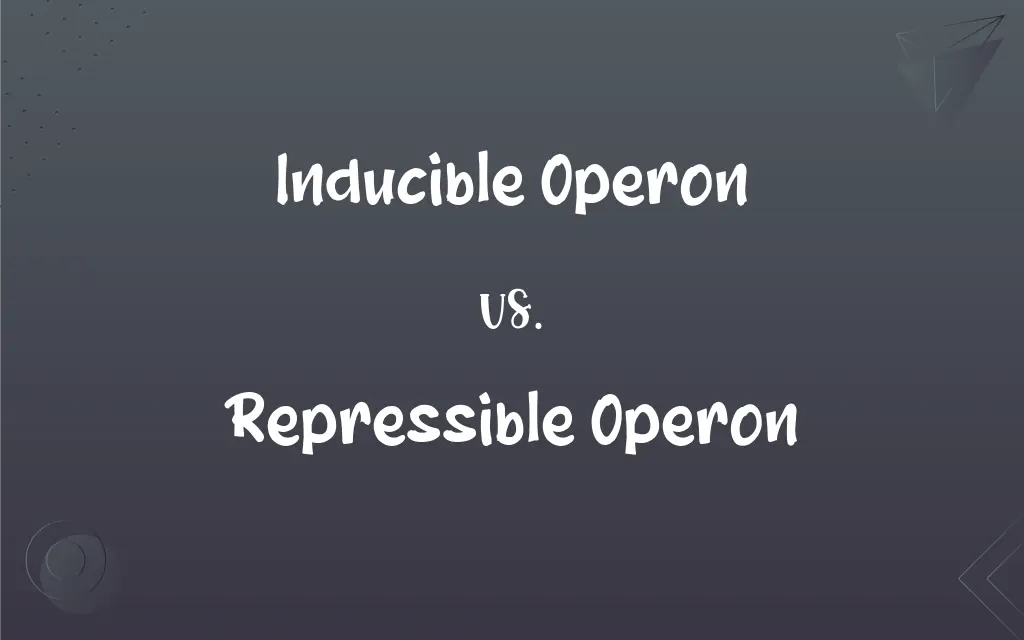Inducible Operon vs. Repressible Operon: What's the Difference?
By Aimie Carlson & Harlon Moss || Published on March 18, 2024
Inducible operons are turned on by the presence of a specific substrate, facilitating the expression of genes needed for its metabolism. Repressible operons are usually on but can be turned off by the product of their gene expression when it is abundant.

Key Differences
Inducible operons, exemplified by the lac operon in bacteria, are part of a gene regulation mechanism that responds to environmental changes by activating gene expression in the presence of a specific inducer (e.g., lactose). This system allows the cell to conserve energy by only producing the necessary enzymes when the substrate is available. Repressible operons, such as the trp operon, operate in reverse; they are normally active but can be inhibited when the cell has sufficient quantities of the end product (e.g., tryptophan), thus preventing the overproduction of substances already abundant in the cell.
The regulation of inducible operons involves the removal of a repressor protein from the operon's operator sequence in the presence of an inducer, allowing RNA polymerase to initiate transcription. In repressible operons, the repressor is inactive until it binds with the corepressor (the end product), forming a complex that can attach to the operator and block transcription.
Inducible operons are critical for the catabolism of substrates, enabling the cell to adapt to nutrient availability by synthesizing enzymes necessary for the breakdown of those substrates. Repressible operons are involved in anabolic pathways, regulating the synthesis of essential biomolecules to prevent excess.
The lac operon and the trp operon serve as classic models for understanding bacterial gene regulation, showcasing how cells efficiently manage resources and respond to environmental fluctuations. The inducible system acts as a switch to turn on gene expression in response to environmental substrates, while the repressible system serves as a feedback mechanism to halt gene expression when cellular needs are met.
Comparison Chart
Activation Trigger
Presence of a specific substrate (inducer).
Presence of high levels of a specific product (corepressor).
ADVERTISEMENT
Typical Role
Catabolic pathways (breaking down substances).
Anabolic pathways (synthesizing substances).
Gene Expression
Normally off, turned on by inducer.
Normally on, turned off by product.
Regulatory Mechanism
Repressor protein is inactivated by the inducer.
Repressor protein activated by binding with corepressor.
Example
Lac operon (lactose metabolism).
Trp operon (tryptophan synthesis).
Inducible Operon and Repressible Operon Definitions
Inducible Operon
Critical in responding to environmental nutrient changes.
E. coli can switch to lactose metabolism when glucose is scarce.
ADVERTISEMENT
Repressible Operon
Manages the synthesis of essential compounds.
The trp operon regulates enzymes for tryptophan production.
Inducible Operon
Regulates genes for catabolic processes.
The lac operon controls enzymes for lactose breakdown.
Repressible Operon
Utilizes a repressor-corepressor mechanism.
Tryptophan acts as a corepressor to turn off its own synthesis pathway.
Inducible Operon
Designed for metabolic flexibility and efficiency.
Bacteria utilize inducible operons to adapt to nutrient availability.
Repressible Operon
Normally active but inhibited by a product's abundance.
The trp operon is repressed by high levels of tryptophan.
Inducible Operon
Involves the inactivation of a repressor to initiate transcription.
Lactose binds to the lac repressor, allowing gene expression.
Repressible Operon
Provides feedback inhibition to conserve resources.
When tryptophan is plentiful, the cell conserves energy by repressing its synthesis.
Inducible Operon
Activated by the presence of a specific inducer substance.
The lac operon is induced by lactose to metabolize it.
Repressible Operon
Functions in biosynthetic pathways.
It ensures that essential amino acids are not overproduced.
FAQs
How does a repressible operon work?
A repressible operon works by being turned off or repressed when a specific end product, serving as a corepressor, binds to a repressor protein, which then attaches to the operon's DNA to inhibit transcription.
What role do repressible operons play in cell metabolism?
Repressible operons play a crucial role in conserving cellular resources by inhibiting the synthesis of compounds that are already abundant within the cell, thus preventing waste.
Can inducible operons be found in humans?
While the concept of inducible operons is most commonly associated with prokaryotic gene regulation, similar principles of inducible gene expression are found in eukaryotes, including humans, though the mechanisms are more complex.
What triggers an inducible operon?
An inducible operon is triggered by the presence of a specific inducer molecule, often a substrate of the metabolic pathway it controls.
Are all operons either inducible or repressible?
While many operons fall into the categories of inducible or repressible, there are also operons with more complex regulation that may not fit neatly into these categories.
What happens to repressible operons in the absence of a corepressor?
In the absence of a corepressor, repressible operons remain active, as the repressor protein cannot bind to the operon's DNA to inhibit transcription.
How do inducer molecules activate inducible operons?
Inducer molecules activate inducible operons by binding to and inactivating a repressor protein, allowing RNA polymerase to initiate transcription of the operon's genes.
How does the presence of glucose affect the lac operon?
The presence of glucose inhibits the lac operon by reducing the levels of cyclic AMP (cAMP), a molecule necessary for the activation of the operon, demonstrating catabolite repression.
Is the regulation of inducible operons reversible?
Yes, the regulation of inducible operons is reversible. Removal of the inducer molecule will result in the repressor protein binding back to the DNA, turning the operon off again.
Why are inducible operons important in bacteria?
Inducible operons are important in bacteria for efficiently responding to environmental changes, such as the availability of nutrients, by expressing the necessary genes only when needed.
What is the significance of allosteric regulation in repressible operons?
Allosteric regulation is significant in repressible operons as it allows the repressor protein to change its shape and bind to the DNA in the presence of a corepressor, effectively turning off the operon.
Can a single gene be part of both an inducible and repressible operon?
While it's uncommon, a single gene can be influenced by both inducible and repressible regulatory elements in complex regulatory networks, particularly in eukaryotic organisms.
How does the efficiency of inducible operons compare to repressible operons?
The efficiency of inducible vs. repressible operons depends on their roles: inducible operons quickly respond to environmental substrates, while repressible operons efficiently prevent waste of resources by inhibiting unnecessary synthesis.
What is the role of the operator in operon regulation?
The operator is a DNA sequence within the operon where the repressor protein binds. Its role is crucial in regulating the on/off state of the operon by either allowing or preventing RNA polymerase access to the genes.
What is an example of a repressible operon in bacteria?
The trp operon in E. coli is a well-known example of a repressible operon that regulates the synthesis of the amino acid tryptophan.
How do environmental factors influence operon regulation?
Environmental factors such as nutrient availability, temperature, and chemical presence can significantly influence operon regulation by affecting the presence or absence of inducers and corepressors, thereby modulating gene expression.
How do inducible and repressible operons contribute to bacterial adaptation?
Inducible and repressible operons contribute to bacterial adaptation by enabling bacteria to rapidly respond to environmental changes, such as nutrient availability, and to conserve resources by regulating the synthesis of essential compounds.
How do mutations affect operon regulation?
Mutations in operon components (such as the promoter, operator, or structural genes) can lead to various regulatory issues, including constitutive expression or complete repression of the operon.
Can inducible operons be partially activated?
Inducible operons typically operate in an "all-or-nothing" manner, where they are either fully activated in the presence of an inducer or remain off; however, the level of induction can vary based on the concentration of the inducer.
Are operons exclusive to prokaryotes?
While operons are most commonly associated with prokaryotes, particularly bacteria, similar gene clusters with coordinated expression exist in some eukaryotic organisms, though they are not operons in the classical sense.
About Author
Written by
Aimie CarlsonAimie Carlson, holding a master's degree in English literature, is a fervent English language enthusiast. She lends her writing talents to Difference Wiki, a prominent website that specializes in comparisons, offering readers insightful analyses that both captivate and inform.
Co-written by
Harlon MossHarlon is a seasoned quality moderator and accomplished content writer for Difference Wiki. An alumnus of the prestigious University of California, he earned his degree in Computer Science. Leveraging his academic background, Harlon brings a meticulous and informed perspective to his work, ensuring content accuracy and excellence.































































